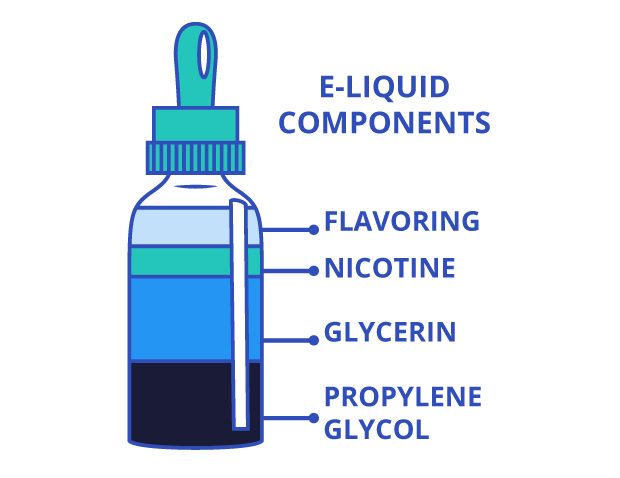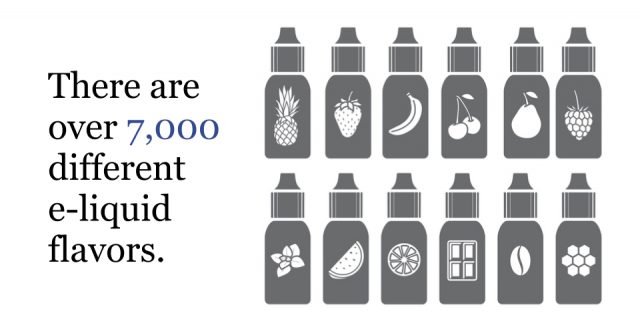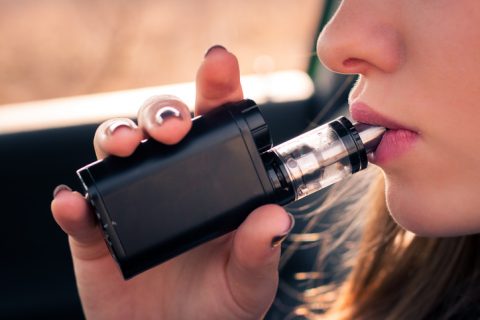E-Cigarette Ingredients
E-cigarettes like Juul contain cartridges or pods of e-liquid made with water, nicotine, a propylene glycol or vegetable glycerin base and flavorings. But with thousands of brands available and no set FDA standards, it can be difficult to determine exactly what is in a vape’s e-liquid.
It’s difficult to determine what is in the thousands of different e-liquids, also called e-juice or vape juice, sold for e-cigarettes. Part of that is because the U.S. Food and Drug Administration hasn’t reviewed ingredients or set standards. There are many brands and flavors with many different ingredients.

While researchers don’t know the exact composition of each e-cigarette, they have identified a few toxic chemicals and metals in e-cigarettes, according to the American Lung Association. Some of these chemicals are known carcinogens — meaning they cause cancer.
According to the FDA’s page, last updated in June 2022, “These products use an ‘e-liquid’ that usually contains nicotine derived from tobacco, as well as flavorings, propylene glycol, vegetable glycerin, and other ingredients. The liquid is heated to create an aerosol that the user inhales.”
Base ingredients such as propylene glycol and vegetable glycerin may be non-toxic when ingested orally, but researchers aren’t sure how safe they are when vaporized and inhaled.
Experts agree that e-cigarettes are less harmful than traditional cigarettes, but e-cigarettes are not considered safe.
- Acetaldehyde and formaldehyde
- These chemicals are known to cause cancer.
- Acrolein
- A weed killer that can cause irreversible lung damage.
- Benzene
- A compound found in car exhaust. Long-term exposure may cause blood problems and cancer of blood-forming organs, such as leukemia.
- Cadmium
- Toxic metal that increases the risk of breathing problems such as chronic obstructive lung disease and emphysema. It’s also found in traditional cigarettes.
- Diacetyl
- Chemical compound used to give food a buttery flavor. Studies link inhaling it to lung disease called bronchiolitis obliterans, also known as “popcorn lung.”
- Diethylene glycol
- Clear odorless liquid with a sweet taste typically found in industrial products such as antifreeze. It’s used as a base in e-liquids. It’s toxic and is linked to lung disease.
- Nickel, tin, lead and other heavy metals
- Heavy metal toxicity may damage functioning of lungs, brain, liver, kidneys and other organs.
- Nicotine
- A highly addictive chemical that can affect the heart and breathing.
- Propylene glycol
- A clear, odorless liquid that’s used as antifreeze and a food addictive. It’s used as a base in e-liquids. It turns to vapor when heated but may produce propylene oxide, a known carcinogen.
How Much Nicotine Is in a Vape?
Nicotine is a highly addictive chemical that comes from the tobacco plant. At one time it was used as an insecticide in the United States. It’s found in most tobacco products, including e-cigarettes.
It only takes about 10 seconds for nicotine to reach the brain after it’s inhaled. Once in the brain, it activates the pleasure centers, giving people feelings of pleasure and relaxation. Nicotine addiction keeps people vaping.
The amount of nicotine in each e-cigarette varies by brand. When it was first released, Juul offered pods containing five percent nicotine, according to Truth Initiative. That’s the equivalent of one pack of cigarettes per pod.
Higher-powered e-cigarettes deliver more nicotine to the brain.
- Abnormal heart rhythms
- Headache
- Increased heart rate
- Muscle twitching
- Rapid breathing
- Seizures
- Stomach upset
- Tremor
Chemical Reactions
Studies have found more than a hundred compounds in e-cigarette liquids. Even more compounds are created when chemicals are heated and vaporized, according to a 2018 review by the National Academies of Sciences, Engineering and Medicine.
These chemicals can pose serious health risks because of chemical reactions with or without heating them.
A 2018 study in Nicotine & Tobacco Research found these reactions between flavorings and propylene glycol, which is used to make the vapor, can expose users to the same potential risks of tobacco cigarettes.
“Even in the absence of heating and combustion, chemical reactions are occurring in e-cigarette liquids and the resulting compounds could be harmful to the user’s airways,” researcher Hanno Erythropel told the American Journal of Managed Care.
Another 2018 study, this one in the journal Scientific Reports, found that chemicals in vape fluid can combine to create various forms of formaldehyde, a naturally occurring chemical that has been linked to certain types of cancer in people with repeated exposure.
Researchers found that under normal vaping conditions, gaseous formaldehyde was produced at levels above those considered safe by the Occupational Safety and Health Administration.
Chemical Exposures Increase with Heating
When heated, chemicals in vape juice can become more toxic. Higher-powered devices can increase levels of toxic chemicals in vapor by aerosolizing ingredients at higher temperatures.
For example, people can vape more than 200 times the level of formaldehyde, acetone and acetaldehyde by increasing the voltage from 3.2 to 4.8. Levels of formaldehyde from high-voltage e-cigarettes were almost the same as traditional cigarette smoke, according to the National Academies of Sciences, Engineering and Medicine.
Harmful Chemicals in Flavored Vape Juice
There are more than 7,000 vape juice flavors available to e-cigarette users, according to the National Academies of Sciences, Engineering, and Medicine. Some of these are considered safe in typical food products when eaten, but may be harmful when inhaled in aerosol form.
A 2015 study conducted by Harvard University researchers found that many different flavorings added to e-liquids in e-cigarettes contain chemicals that may be harmful to users’ long-term health.

Some flavors included in the study were: Classic, Menthol, Cherry Crush, Java Jolt, Pina Colada, Vanilla Bean, Bad Apple, Iced Berry, Banana, Pomegranate, Peach Pit, Watermelon, CooCoo Coconut, Pineapple Punch, Carmel Popcorn, Bubble Gum, Cotton Candy and Tutti Frutti.
Results showed that at least one of the three common flavoring chemicals — diacetyl, 2,3 pentanedione or acetoin — was present in 47 of the 51 flavors tested.
- Diacetyl was found in 39 of 51 flavors tested.
- 2,3-pentanedione was found in 23 of the 51 flavors.
- Acetoin was found in 46 of the 51 flavors.
- Diacetyl and 2,3-pentanedione were present simultaneously in 21 flavors tested.
- 2,3-pentanedione and acetoin were found simultaneously in 22 flavors.
Inaccurate Labeling
Studies have also found that product labels aren’t always accurate. This can make it difficult for consumers to know what they are ingesting.
For example, one 2016 study published in Journal of Pediatric Nursing by Kelly Buettner-Schmidt and colleagues found that mislabeling was common.
The University of North Dakota researchers collected 94 e-liquid samples. More than half were mislabeled by at least 10 percent.
Seventeen percent had more nicotine than listed on the label, and one of those samples contained 172 percent more nicotine than was listed on the label.
Calling this number connects you with a Drugwatch.com representative. We will direct you to one of our trusted legal partners for a free case review.
Drugwatch.com's trusted legal partners support the organization's mission to keep people safe from dangerous drugs and medical devices. For more information, visit our partners page.



